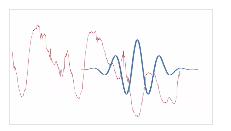Wavelet Transform Video Series
Video 1: Introduction to Wavelet Transform
Video 2: Wavelet Transform based Preprocessing and Features Extraction
Video 3: Wavelet Transform in Machine Learning
Video 4: Acceleration & Deployment
Analyze signals and images in the wavelet domain
While Fourier analysis consists of decomposing a signal into sine waves of specific frequencies, wavelet analysis is based on decomposing signals into shifted and scaled versions of a wavelet. A wavelet, unlike a sine wave, is a rapidly decaying, wave-like oscillation. This enables wavelets to represent data across multiple scales. Different wavelets can be used depending on the application. Wavelet Toolbox™ for use with MATLAB supports Morlet, Morse, Daubechies, and other wavelets used in wavelet analysis.
Audio signals, time-series financial data, and biomedical signals typically exhibit piecewise smooth behavior punctuated by transients. Similarly, images typically include homogenous, piecewise smooth regions separated by transients, which appear as edges. For both signals and images, the smooth regions and transients can be sparsely represented with wavelet transforms.
Continuous Wavelet Transform (CWT) and Discrete Wavelet Transform (DWT).
Wavelet transforms can be classified into two broad classes: the continuous wavelet transform (CWT) and the discrete wavelet transform (DWT).
The continuous wavelet transform is a time-frequency transform, which is ideal for analysis of non-stationary signals. A signal being nonstationary means that its frequency-domain representation changes over time. CWT is similar to the short-time Fourier transform (STFT). The STFT uses a fixed window to create a local frequency analysis, while CWT tiles the time-frequency plane with variable-sized windows. The window widens in time, making it suitable for low-frequency phenomena, and narrows for high-frequency phenomena. The continuous wavelet transform can be used to analyze transient behavior, rapidly changing frequencies, and slowly varying behavior.


